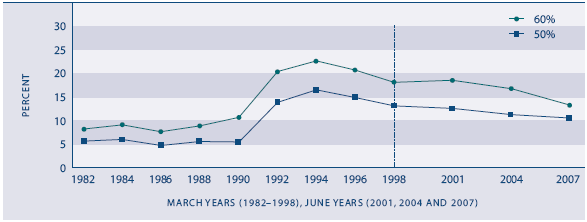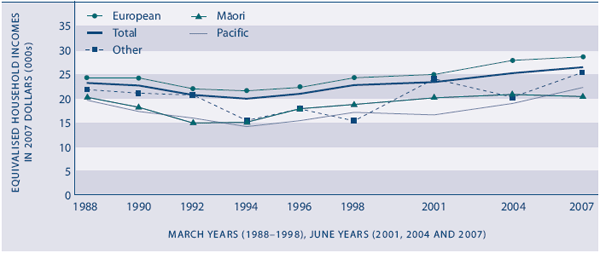Population with low incomes
Definition
The proportion of the population in households with equivalised disposable income net-ofhousing-cost below two thresholds.
Incomes are after deducting tax and housing costs, and adjusting for household size and composition. The thresholds are 50 and 60 percent of 1998 household disposable income median, with 25 percent deducted to allow for average housing costs. The thresholds are adjusted for inflation to keep them fixed in real terms.
Relevance
Insufficient economic resources limit people’s capability to participate in and belong to their community and wider society and otherwise restrict their quality of life. Furthermore, long-lasting low family income in childhood is associated with negative outcomes, such as lower educational attainment and poorer health.
Current level and trends
In the year to June 2007, 13 percent of the population was living below the 60 percent threshold, down from 17 percent in the previous survey year to June 2004. The proportion of the population with low incomes rose sharply from 1990, reached a peak in the mid-1990s and has generally declined since then. However, in 2007, the proportion was still above what it had been in the 1980s.
The increase in the proportion of the population with low incomes in the early-1990s is attributable to declining household incomes arising from high rates of unemployment and reduced levels of social assistance. The improvement since the mid-1990s reflects more robust economic (and income) growth, the steady decline in unemployment, the increase in housing assistance and the increase in tax credits for families with children. Rates remain higher in 2007 than they were in the 1980s partly because housing costs for low-income households have risen significantly as a proportion of their household incomes.
Figure EC3.1 Proportion of population with net-of-housing-cost household incomes below thresholds, 1982–1998, 2001, 2004 and 2007

Source: Derived from Statistics New Zealand's Household Economic Survey (1982–2007), by the Ministry of Social Development
Population group differences
In 2007, a lower proportion of older people than younger people were below the 60 percent threshold, although the difference between younger and older people was much smaller in 2007 than a decade before. The relatively low rates for older New Zealanders reflect their high rate of mortgage-free home ownership.
In 2007, 16 percent of dependent children were in households with incomes below the 60 percent threshold, a substantial decline from 23 percent in 2004. The 2007 rate was less than half of the peak rate of 35 percent in 1994, but it was still above the levels of the mid-1980s (11 percent). Rates for females aged 15 years and over have generally been a little higher than those for males of the same age group from 1986 to 2007.
Table EC3.1 Proportions (%) in low-income households (60 percent threshold), by age and sex, selected years, 1986–2007
| Year |
Children
0-17 |
18–24 |
25–44 |
45–64 |
65+ |
Males
15 + |
Females
15+ |
Total |
| 1986 |
11 |
5 |
8 |
5 |
4 |
5 |
7 |
8 |
| 1990 |
16 |
8 |
12 |
6 |
6 |
8 |
9 |
11 |
| 1994 |
35 |
20 |
23 |
15 |
8 |
17 |
20 |
23 |
| 1998 |
28 |
16 |
18 |
12 |
9 |
13 |
16 |
18 |
| 2001 |
29 |
21 |
18 |
14 |
7 |
14 |
17 |
19 |
| 2004 |
23 |
22 |
17 |
13 |
7 |
15 |
15 |
17 |
| 2007 |
16 |
17 |
13 |
11 |
8 |
11 |
13 |
13 |
Source: Derived from Statistics New Zealand's Household Economic Survey (1986–2007), by the Ministry of Social Development
Ethnic differences
Sample sizes in the source data are not large enough to support a reliable time series for proportions below the 60 percent threshold by ethnic group (see Appendix 2 for more details). Trends in real equivalised median household incomes are less volatile and are used to give an idea of the relativities between ethnic groups. Median incomes for all ethnic groups rose from the low point in 1994 through to 2007, although for Māori median incomes remained almost unchanged from 2004 to 2007.
Figure EC3.2 Real equivalised median household incomes, by ethnic group, 1988–1998, 2001, 2004 and 2007

Source: Derived from Statistics New Zealand's Household Economic Survey (1982–2007), by the Ministry of Social Development
Note: Household ethnicity is defined by the presence, within the household, of an adult of a particular ethnic group
Household and family type differences
Since 2001, the proportion of people in families with dependent children who were below the 60 percent threshold has declined. Between 2001 and 2007, the rate for those in two-parent families fell from 19 percent to 9 percent, while the rate for those in sole-parent families fell from 61 percent to 40 percent. Households with three or more children have a higher proportion under the 60 percent threshold than those with fewer children (19 percent and 14 percent respectively in 2007). The proportion of those under 65 years in one-person households who were below the threshold increased from around 12 percent in the late-1980s to 30 percent in the mid-1990s and was still 30 percent in 2007.
International comparison
For international comparisons, a different measure is used. The OECD measure is 50 percent of median (current year median rather than fixed line) equivalent disposable household income, which does not take into account housing costs. In 2004, 11 percent of New Zealanders were living in households with incomes below this threshold. The most recent OECD comparison (from 2004) places New Zealand 16th out of 30 OECD countries, and only just above the OECD median (10 percent). New Zealand’s rate is similar to those of Germany, Canada and Australia (11–12 percent) and well below that of the United States (17 percent).63 Sweden and Denmark have the lowest proportion of their populations with low incomes (5–6 percent). By 2007, the New Zealand rate was 12 percent.
|


